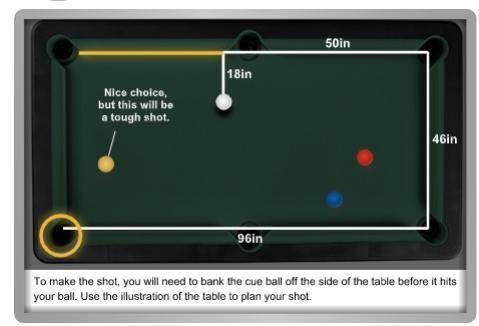
Mathematics, 12.12.2021 22:10 starlodgb1971
WILL GIVE PONITS
Setting Up for the Shot. You're playing a game of pool and it's your turn, but you have no direct shots. To make any shot, you will need to bank the cue ball (the white ball) off the side of the table before it hits your ball. That means that you hit the cue ball so that it bounces off the side and then hits your colored ball, moving it in the direction of a pocket (hole). The angle that the ball hits the bumper is equal to the angle that it bounces off the bumper.
The cue ball is 18 inches from the top bumper (side of pool table) and 50 inches from the right bumper. The dimensions of the pool table are 96 inches in the horizontal direction by 46 inches in the vertical direction. Use the illustration of the table and what you know about similar triangles to plan your shot.
1. Which ball did you select? Red, yellow, or blue? (1 point: 1 point for selection)
Yellow
2. Construct a triangle by performing each of these steps. (6 points: 1 point for each step)
a. Label the cue (white) ball A.
b. Identify the pocket (hole) that you want your ball to go in. Label the center of this pocket E.
(Hint: Click on the ball in the image on the Pool Table Problem page to see how to make this shot.)
c. Draw a line segment that starts at E, goes through the colored ball, and ends at the other side of the table. Label the other endpoint of the segment C.
d. Draw a line segment from C to A (the cue ball). This segment will make the same angle with the bumper as CE.
e. Draw a perpendicular line segment from A to the same bumper (side of table) C is on. Label the endpoint B.
f. Complete triangle ABC by drawing the line segment BC.
3. Complete triangle CDE that is similar to ABC. Where does D need to be to create a similar triangle? Label vertex D and mark the angles that have the same measure. (2 points)
4. Assign a variable to name the length of BC and label it on your figure. To identify the lengths of AB, CD, and DE, use the dimensions of the pool table. Some lengths will include a variable. (4 points: 1 point for each label)
5. Use your similar triangles to set up a proportion. Solve this proportion for the unknown variable, the length of BC. (5 points: 2 points for the proportion, 3 points for the work.
6. To make your shot, you need the cue ball to hit point C. Find length CD and use it to identify the location of C in relation to one of the corner pockets. For example, if C is on the upper bumper, your answer might be: 15 inches to the right of the upper left pocket. Round your answer to the nearest inch. (2 points: 1 point for distance, 1 point for location)


Answers: 3
Another question on Mathematics

Mathematics, 21.06.2019 12:30
(note i put the graph in so plz )the graph shows the amount of water that remains in a barrel after it begins to leak. the variable x represents the number of days that have passed since the barrel was filled, and y represents the number of gallons of water that remain in the barrel. what is the slope of the line
Answers: 1

Mathematics, 21.06.2019 17:20
Researchers were interested in whether relaxation training decreases the number of headaches a person experiences. they randomly assigned 20 participants to a control group or a relaxation training group and noted the change in number of headaches each group reported from the week before training to the week after training. which statistical analysis should be performed to answer the researchers' question?
Answers: 2

Mathematics, 21.06.2019 17:40
Aregular hexagon has sides of 2 feet. what is the area of the hexagon? 12 ft2 12 ft2 24 ft2 6 ft2
Answers: 2

You know the right answer?
WILL GIVE PONITS
Setting Up for the Shot. You're playing a game of pool and it's your turn, but yo...
Questions

History, 29.06.2019 23:00

Mathematics, 29.06.2019 23:00

Mathematics, 29.06.2019 23:00


Social Studies, 29.06.2019 23:00

Mathematics, 29.06.2019 23:00

English, 29.06.2019 23:00

Mathematics, 29.06.2019 23:00


English, 29.06.2019 23:00


Health, 29.06.2019 23:00

English, 29.06.2019 23:00

Mathematics, 29.06.2019 23:00

History, 29.06.2019 23:00

History, 29.06.2019 23:00

Mathematics, 29.06.2019 23:00

Mathematics, 29.06.2019 23:00

Biology, 29.06.2019 23:00

Physics, 29.06.2019 23:00



